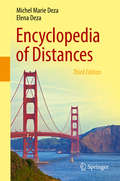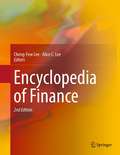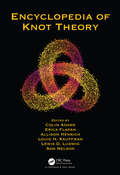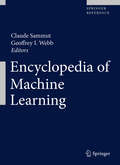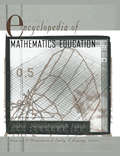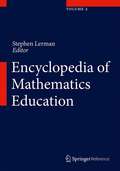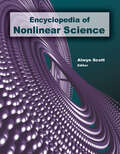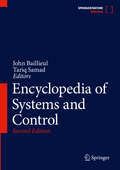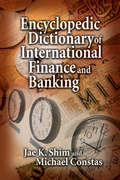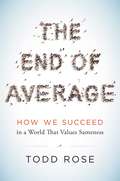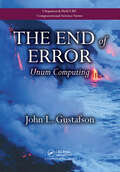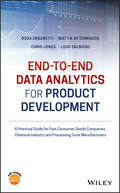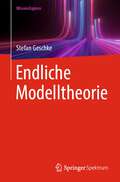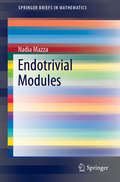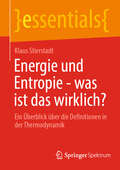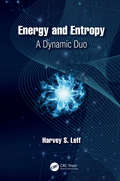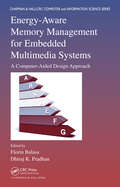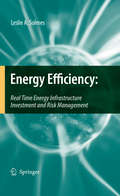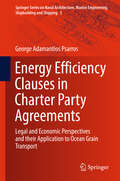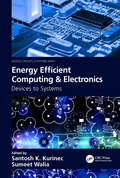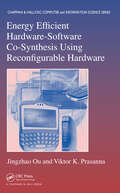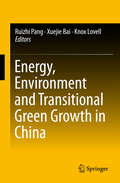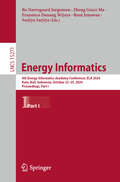- Table View
- List View
Encyclopedia of Distances
by Elena Deza Michel Marie DezaThis 4-th edition of the leading reference volume on distance metrics is characterized by updated and rewritten sections on some items suggested by experts and readers, as well a general streamlining of content and the addition of essential new topics. Though the structure remains unchanged, the new edition also explores recent advances in the use of distances and metrics for e. g. generalized distances, probability theory, graph theory, coding theory, data analysis. New topics in the purely mathematical sections include e. g. the Vitanyi multiset-metric, algebraic point-conic distance, triangular ratio metric, Rossi-Hamming metric, Taneja distance, spectral semimetric between graphs, channel metrization, and Maryland bridge distance. The multidisciplinary sections have also been supplemented with new topics, including: dynamic time wrapping distance, memory distance, allometry, atmospheric depth, elliptic orbit distance, VLBI distance measurements, the astronomical system of units, and walkability distance. Leaving aside the practical questions that arise during the selection of a 'good' distance function, this work focuses on providing the research community with an invaluable comprehensive listing of the main available distances. As well as providing standalone introductions and definitions, the encyclopedia facilitates swift cross-referencing with easily navigable bold-faced textual links to core entries. In addition to distances themselves, the authors have collated numerous fascinating curiosities in their Who's Who of metrics, including distance-related notions and paradigms that enable applied mathematicians in other sectors to deploy research tools that non-specialists justly view as arcane. In expanding access to these techniques, and in many cases enriching the context of distances themselves, this peerless volume is certain to stimulate fresh research.
Encyclopedia of Finance
by Alice C. Lee Cheng-Few LeeThe Encyclopedia of Finance, Second Edition, comprised of over 1000 individual definitions and chapters, is the most comprehensive and up-to-date resource in the field, integrating the most current terminology, research, theory, and practical applications. Showcasing contributions from an international array of experts, the revised edition of this major reference work is unparalleled in the breadth and depth of its coverage. Part I provides readers with a basic framework for getting up to speed quickly, and has been updated to include over 200 new terms and essays. Part II features 24 new chapters and offers a more in-depth look at the topic through key developments and findings. Part III has also been expanded through the addition of four new appendices. From "asset pricing models" to "risk management," the Encyclopedia of Finance, Second Edition, serves as an essential resource for academics, educators, and students.
Encyclopedia of GIS
by Shashi Shekhar Hui XiongThe Encyclopedia of GIS provides a comprehensive and authoritative guide, contributed by experts and peer-reviewed for accuracy, and alphabetically arranged for convenient access. The entries explain key software and processes used by geographers and computational scientists. Major overviews are provided for nearly 200 topics: Geoinformatics, Spatial Cognition, and Location-Based Services and more. Shorter entries define specific terms and concepts. The reference will be published as a print volume with abundant black and white art, and simultaneously as an XML online reference with hyperlinked citations, cross-references, four-color art, links to web-based maps, and other interactive features.
Encyclopedia of Knot Theory
by Colin Adams Erica Flapan Allison Henrich Louis H. Kauffman Lewis D. Ludwig Sam Nelson"Knot theory is a fascinating mathematical subject, with multiple links to theoretical physics. This enyclopedia is filled with valuable information on a rich and fascinating subject." – Ed Witten, Recipient of the Fields Medal "I spent a pleasant afternoon perusing the Encyclopedia of Knot Theory. It’s a comprehensive compilation of clear introductions to both classical and very modern developments in the field. It will be a terrific resource for the accomplished researcher, and will also be an excellent way to lure students, both graduate and undergraduate, into the field." – Abigail Thompson, Distinguished Professor of Mathematics at University of California, Davis Knot theory has proven to be a fascinating area of mathematical research, dating back about 150 years. Encyclopedia of Knot Theory provides short, interconnected articles on a variety of active areas in knot theory, and includes beautiful pictures, deep mathematical connections, and critical applications. Many of the articles in this book are accessible to undergraduates who are working on research or taking an advanced undergraduate course in knot theory. More advanced articles will be useful to graduate students working on a related thesis topic, to researchers in another area of topology who are interested in current results in knot theory, and to scientists who study the topology and geometry of biopolymers. Features Provides material that is useful and accessible to undergraduates, postgraduates, and full-time researchers Topics discussed provide an excellent catalyst for students to explore meaningful research and gain confidence and commitment to pursuing advanced degrees Edited and contributed by top researchers in the field of knot theory
Encyclopedia of Machine Learning
by Claude Sammut Geoffrey I. WebbThis comprehensive encyclopedia, in A-Z format, provides easy access to relevant information for those seeking entry into any aspect within the broad field of Machine Learning. Most of the entries in this preeminent work include useful literature references.
Encyclopedia of Mathematics Education
by Louise Grinstein Sally I. LipseyThis single-volume reference is designed for readers and researchers investigating national and international aspects of mathematics education at the elementary, secondary, and post-secondary levels. It contains more than 400 entries, arranged alphabetically by headings of greatest pertinence to mathematics education. The scope is comprehensive, encompassing all major areas of mathematics education, including assessment, content and instructional procedures, curriculum, enrichment, international comparisons, and psychology of learning and instruction.
Encyclopedia of Mathematics Education
by Stephen LermanThe Encyclopedia of Mathematics Education is a comprehensive reference text, covering every topic in the field with entries ranging from short descriptions to much longer pieces where the topic warrants more elaboration. The entries provide access to theories and to research in the area and refer to the leading publications for further reading. Links will also be made to particular texts in Springer journals and e-books through SpringerReference. com. The Encyclopedia is aimed at graduate students, researchers, curriculum developers, policy makers, and others with interests in the field of mathematics education. It is planned to be 700 pages in length in its hard copy form but the text will subsequently be up-dated and developed on-line in a way that retains the integrity of the ideas, the responsibility for which will be in the hands of the Editor-in-Chief and the Editorial Board. Editorial Board: Michele ArtigueRuhama EvenMelony GravenEva JablonkaRobyn JorgensenYoshinori ShimizuBharath Sriraman
Encyclopedia of Nonlinear Science
by Alwyn ScottIn 438 alphabetically-arranged essays, this work provides a useful overview of the core mathematical background for nonlinear science, as well as its applications to key problems in ecology and biological systems, chemical reaction-diffusion problems, geophysics, economics, electrical and mechanical oscillations in engineering systems, lasers and nonlinear optics, fluid mechanics and turbulence, and condensed matter physics, among others.
Encyclopedia of Software Engineering Three-Volume Set (Print)
by Phillip A. LaplanteSoftware engineering requires specialized knowledge of a broad spectrum of topics, including the construction of software and the platforms, applications, and environments in which the software operates as well as an understanding of the people who build and use the software. Offering an authoritative perspective, the two volumes of the Encyclopedia of Software Engineering cover the entire multidisciplinary scope of this important field. More than 200 expert contributors and reviewers from industry and academia across 21 countries provide easy-to-read entries that cover software requirements, design, construction, testing, maintenance, configuration management, quality control, and software engineering management tools and methods. Editor Phillip A. Laplante uses the most universally recognized definition of the areas of relevance to software engineering, the Software Engineering Body of Knowledge (SWEBOK®), as a template for organizing the material. Also available in an electronic format, this encyclopedia supplies software engineering students, IT professionals, researchers, managers, and scholars with unrivaled coverage of the topics that encompass this ever-changing field. Also Available OnlineThis Taylor & Francis encyclopedia is also available through online subscription, offering a variety of extra benefits for researchers, students, and librarians, including: Citation tracking and alerts Active reference linking Saved searches and marked lists HTML and PDF format options Contact Taylor and Francis for more information or to inquire about subscription options and print/online combination packages.US: (Tel) 1.888.318.2367; (E-mail) e-reference@taylorandfrancis.comInternational: (Tel) +44 (0) 20 7017 6062; (E-mail) online.sales@tandf.co.uk
Encyclopedia of Systems and Control
by John Baillieul Tariq SamadThe Encyclopedia of Systems and Control collects a broad range of short expository articles that describe the current state of the art in the central topics of control and systems engineering as well as in many of the related fields in which control is an enabling technology. The editors have assembled the most comprehensive reference possible, and this has been greatly facilitated by the publisher’s commitment to continuously publish updates to the articles as they become available in the future. Although control engineering is now a mature discipline, it remains an area in which there is a great deal of research activity, and as new developments in both theory and applications become available, they will be included in the online version of the encyclopedia. A carefully chosen team of leading authorities in the field has written the well over 300 articles, 50 of them new in the second edition. The topics range from basic principles of feedback in servomechanisms to advanced topics such as the control of Boolean networks and evolutionary game theory and this range has also been expanded to include material on such subjects as the Internet of Things, quantum control and smart grids. Because the content has been selected to reflect both foundational importance and subjects that are of current interest to the research and practitioner communities, a broad readership that includes students, application engineers, and research scientists will find entries that are of interest.
Encyclopedic Dictionary of International Finance and Banking
by Jae K. Shim Michael ConstasThe Encyclopedic Dictionary of International Finance and Banking is a practical reference of proven techniques, strategies, and approaches. It covers virtually all important topics dealing with multinational business finance, money, investments, financial planning, financial economics, and banking. In addition, it explores the application of comput
The End of Average: How We Succeed in a World That Values Sameness
by Todd RoseAre you above average? Is your child an A (or a C) student? Is your employee an introvert or an extrovert? Every day we are measured against the yardstick of averages, judged according to how closely we resemble it or how far we deviate from it. The assumption that metrics comparing us to an average--like development milestones, GPAs, personality assessments, standardized test results, and performance review ratings--reveal something meaningful about our potential is so ingrained in our consciousness that we rarely question it. That assumption, says Harvard's Todd Rose, is spectacularly--and scientifically--wrong.In The End of Average, Rose shows that no one is average. Not you. Not your kids. Not your employees or students. This isn't hollow slogan-eering--it's a mathematical fact with enormous practical consequences. But while we know people learn and develop in distinctive ways, these unique patterns of behaviors are lost in our schools and businesses which have been designed around the mythical "average person." For more than a century, this average-size-fits-all model has ignored our individuality and failed at recognizing talent. It's time to change that.Weaving science, history, and his experiences as a high school dropout, Rose brings to life the untold story of how we came to embrace the scientifically flawed idea that averages can be used to understand individuals and offers a powerful alternative: the three principles of individuality. The jaggedness principle (talent is never one- dimensional), the context principle (traits are a myth), and the pathways principle (we all walk the road less traveled) help us understand our true uniqueness--and that of others--and how to take full advantage of individuality to gain an edge in life.This powerful book will forever change how you see averages and talent.Praise for The End of Average " Todd Rose shows that everything we think we know about 'average' performance is wrong. In fact, our one-dimensional understanding of achievement--our search for the average score, average grade, average talent--has seriously underestimated human potential. This book is readable, enlightening, and way above average."--DANIEL H. PINK, author of To Sell Is Human and Drive " Fascinating, engaging, and practical. Todd Rose dispels the myth that our success can be divined by a simple number or average, whether a grade, a score in a standardized test, or a ranking at work. The End of Average will help everyone--and I mean everyone--live up to their potential."--AMY CUDDY, professor at Harvard Business School and author of Presence" Todd Rose has achieved a rare feat: he is both provocative and right. He overturns our fundamental assumptions about talent, and offers an empowering way to re-think the world. With exciting stories, fresh data, and bold ideas, this book is far better than average."--ADAM GRANT, Wharton professor and New York Times bestselling author of Give and Take and Originals " Consistently mind-blowing!"--Dan Heath, coauthor of the New York Times bestsellers Made to Stick, Switch, Decisive" Todd Rose's thought-provoking book challenges the explanatory power of the everyday term 'average,' opening our minds to new ways of conceptualizing human variation and human potentials."--HOWARD GARDNER, author of Truth, Beauty, and Goodness Reframed " In the midst of a war for talent, we miss huge opportunities to find it. This stunning book shows how almost all the measures we use reduce complicated individuals to one-dimensional beings. As a result, we overlook how talent, context, and disposition fold together to create individual uniqueness. I couldn't put this book down."--JOHN SEELY BROWN, independent cochair of Deloitte's Center for the Edge and coauthor of The Social Life of Information, The Power of Pull, and The New Culture of Learning
The End of Error: Unum Computing (Chapman & Hall/CRC Computational Science #24)
by John L. GustafsonThe Future of Numerical Computing Written by one of the foremost experts in high-performance computing and the inventor of Gustafson’s Law, The End of Error: Unum Computing explains a new approach to computer arithmetic: the universal number (unum). The unum encompasses all IEEE floating-point formats as well as fixed-point and exact integer arithmetic. This new number type obtains more accurate answers than floating-point arithmetic yet uses fewer bits in many cases, saving memory, bandwidth, energy, and power. A Complete Revamp of Computer Arithmetic from the Ground Up Richly illustrated in color, this groundbreaking book represents a fundamental change in how to perform calculations automatically. It illustrates how this novel approach can solve problems that have vexed engineers and scientists for decades, including problems that have been historically limited to serial processing. Suitable for Anyone Using Computers for Calculations The book is accessible to anyone who uses computers for technical calculations, with much of the book only requiring high school math. The author makes the mathematics interesting through numerous analogies. He clearly defines jargon and uses color-coded boxes for mathematical formulas, computer code, important descriptions, and exercises.
End-to-end Data Analytics for Product Development: A Practical Guide for Fast Consumer Goods Companies, Chemical Industry and Processing Tools Manufacturers (Wiley Series In Probability And Statistics Ser. #564)
by Rosa Arboretti Giancristofaro Mattia De Dominicis Chris Jones Luigi SalmasoAn interactive guide to the statistical tools used to solve problems during product and process innovation End to End Data Analytics for Product Development is an accessible guide designed for practitioners in the industrial field. It offers an introduction to data analytics and the design of experiments (DoE) whilst covering the basic statistical concepts useful to an understanding of DoE. The text supports product innovation and development across a range of consumer goods and pharmaceutical organizations in order to improve the quality and speed of implementation through data analytics, statistical design and data prediction. The book reviews information on feasibility screening, formulation and packaging development, sensory tests, and more. The authors – noted experts in the field – explore relevant techniques for data analytics and present the guidelines for data interpretation. In addition, the book contains information on process development and product validation that can be optimized through data understanding, analysis and validation. The authors present an accessible, hands-on approach that uses MINITAB and JMP software. The book: • Presents a guide to innovation feasibility and formulation and process development • Contains the statistical tools used to solve challenges faced during product innovation and feasibility • Offers information on stability studies which are common especially in chemical or pharmaceutical fields • Includes a companion website which contains videos summarizing main concepts Written for undergraduate students and practitioners in industry, End to End Data Analytics for Product Development offers resources for the planning, conducting, analyzing and interpreting of controlled tests in order to develop effective products and processes.
Endliche Modelltheorie
by Stefan GeschkeDieses Buch basiert auf dem Skript zu einer Vorlesung über endliche Modelltheorie an der Freien Universität Berlin und dient als eine kurze Einführung in das Thema. Vorausgesetzt wird dabei eine gewisse Vertrautheit mit mathematischer Notation und grundlegenden Konzepten, wie zum Beispiel Mengen, die man in einer einführenden Mathematikvorlesung für Studierende der Mathematik, Informatik oder der Naturwissenschaften erwirbt. Ausdrücklich nicht vorausgesetzt werden Kenntnisse in mathematischer Logik.Die Produktfamilie WissensExpress bietet Ihnen Lehr- und Lernbücher in kompakter Form. Die Bücher liefern schnell und verständlich fundiertes Wissen.
Endotrivial Modules (SpringerBriefs in Mathematics)
by Nadia MazzaThis is an in-depth report on the endotrivial modules, an important class of modular representations for finite groups.Following the historical development of the theory, the book starts with a review of the necessary definitions and some key examples. The main results obtained using traditional techniques are then presented, followed by more recent results such as the work of Grodal inspired by algebraic topology. In the last part of the book original methods are applied to obtain the group of endotrivial modules for certain very important groups. An accessible reference collecting half a century of research on endotrivial modules, this book will be of interest to researchers in algebra.
Energie und Entropie - was ist das wirklich?: Ein Überblick über die Definitionen in der Thermodynamik (essentials)
by Klaus StierstadtDieses essential beschreibt zwei der wichtigsten physikalischen Begriffe, die Energie und die Entropie. Die innere und die äußere Energie von Materie und Feldern wird definiert und an Beispielen erläutert. Die Energie kann in vielerlei Formen existieren, die zum Teil ineinander umgewandelt werden können. Ob das möglich ist oder nicht, das beschreiben der Zweite Hauptsatz der Thermodynamik und die Entropie. Diese kann auf zweierlei Weise definiert werden, auf thermodynamischer und auf statistischer Grundlage. Der weitgehend geheimnisvolle Begriff der Entropie wird erläutert und seine Missdeutungen werden beschrieben.
Energy and Entropy: A Dynamic Duo
by Harvey S. LeffEnergy is typically regarded as understandable, despite its multiple forms of storage and transfer. Entropy, however, is an enigma, in part because of the common view that it represents disorder. That view is flawed and hides entropy’s connection with energy. In fact, macroscopic matter stores internal energy, and that matter’s entropy is determined by how the energy is stored. Energy and entropy are intimately linked. Energy and Entropy: A Dynamic Duo illuminates connections between energy and entropy for students, teachers, and researchers. Conceptual understanding is emphasised where possible through examples, analogies, figures, and key points. Features: Qualitative demonstration that entropy is linked to spatial and temporal energy spreading, with equilibrium corresponding to the most equitable distribution of energy, which corresponds to maximum entropy Analysis of energy and entropy of matter and photons, with examples ranging from rubber bands, cryogenic cooling, and incandescent lamps to Hawking radiation of black holes Unique coverage of numerical entropy, the 3rd law of thermodynamics, entropic force, dimensionless entropy, free energy, and fluctuations, from Maxwell's demon to Brownian ratchets, plus attempts to violate the second law of thermodynamics
Energy-Aware Memory Management for Embedded Multimedia Systems: A Computer-Aided Design Approach (Chapman & Hall/CRC Computer and Information Science Series)
by Florin Balasa Dhiraj K. PradhanEnergy-Aware Memory Management for Embedded Multimedia Systems: A Computer-Aided Design Approach presents recent computer-aided design (CAD) ideas that address memory management tasks, particularly the optimization of energy consumption in the memory subsystem. It explains how to efficiently implement CAD solutions, including theoretical methods an
Energy Efficiency: Real Time Energy Infrastructure Investment and Risk Management
by Leslie A. SolmesENERGY EFFICIENCY uses an applied scientific methodology and case studies to demonstrate and support: The need for the U.S. and the world to commit to energy and resource efficiency as the central goal in investing in electric, heat, and cooling infrastructure, the huge economic opportunity for using the inefficiency built into 20th century energy supply systems, especially, electric, to pay for the upgrades, replacements, and new production and distribution systems of the 21st century, the importance of adopting a standard, web-based energy infrastructure investment decision-making and risk management tool that will serve as a communication medium for all stakeholders to evaluate and compare energy infrastructure investment options and manage investment risks, expansions of the U.S. 'smart' grid investment to include evaluation and risk management of energy systems infrastructure investments not just electricity operations, the need to adopt a 'framework' for utilities, energy service companies, and customers to work together to close business deals, communicate and manage risks, and realize profits.
Energy Efficiency Clauses in Charter Party Agreements
by George Adamantios PsarrosThis book provides practical solutions for addressing energy efficiency as a clause term within a charter party contract. For this, upon a reflection of the regulatory craft, it analyzes key concepts of case law, and discusses them together with commercial and economic principles. In this way, the book aims at offering a comprehensive, interdisciplinary view of the chartering process, together with a new approach for safeguarding energy efficiency investments. A special emphasis is given to the maritime industry. Here, the newly developed framework, based on game theory, has been successfully applied to demonstrate the importance of including a clause term in contract negotiation to achieve protection against both an uncertain market and an even more challenging shipping environment. The book not only fills a gap in the literature, covering a topic that has been largely neglected to date, yet it offers researchers and practitioners extensive information to change the chartering process radically.
Energy Efficient Computing & Electronics: Devices to Systems (Devices, Circuits, and Systems)
by Krzysztof Iniewski, Santosh K. Kurinec and Sumeet WaliaIn our abundant computing infrastructure, performance improvements across most all application spaces are now severely limited by the energy dissipation involved in processing, storing, and moving data. The exponential increase in the volume of data to be handled by our computational infrastructure is driven in large part by unstructured data from countless sources. This book explores revolutionary device concepts, associated circuits, and architectures that will greatly extend the practical engineering limits of energy-efficient computation from device to circuit to system level. With chapters written by international experts in their corresponding field, the text investigates new approaches to lower energy requirements in computing. Features • Has a comprehensive coverage of various technologies • Written by international experts in their corresponding field • Covers revolutionary concepts at the device, circuit, and system levels
Energy Efficient Hardware-Software Co-Synthesis Using Reconfigurable Hardware (Chapman & Hall/CRC Computer and Information Science Series)
by Jingzhao Ou Viktor K. PrasannaRapid energy estimation for energy efficient applications using field-programmable gate arrays (FPGAs) remains a challenging research topic. Energy dissipation and efficiency have prevented the widespread use of FPGA devices in embedded systems. Helping overcome these challenges, this book offers solutions for the development of energy efficient applications using FPGAs. It provides a framework for high-level hardware-software application development, describes energy performance modeling for reconfigurable system-on-chip devices, and explores energy efficient designs for various applications. The authors present a two-step rapid energy estimation technique that enables high-level design space exploration and offer a hardware-software design for energy efficient implementations of operating systems.
Energy, Environment and Transitional Green Growth in China
by Ruizhi Pang Xuejie Bai Knox LovellThis book discusses energy use and its environmental footprint in China, as well as issues concerning the transitional green growth of its economy, a subject of great importance in light of China’s size and its impressive record of economic growth. The book includes expert overviews and empirical studies prepared by internationally recognized experts in the field. The empirical techniques utilized by the contributors include econometrics, mathematical programming, and index numbers. The book will provide readers a deeper understanding of the energy and environmental issues China now faces during its transitional growth period, and of the strategies available for resolving these issues. The 2016 Asia-Pacific Productivity Conference, held in Nankai University, Tianjin China from July 7-10, was organized by Nankai University’s College of Economic and Social Development (CESD) in collaboration with the School of Economics Nankai University and Collaborative Innovation Center for China Economy. The primary objective of the event was to highlight the latest developments in efficiency and productivity research.
Energy Informatics: 4th Energy Informatics Academy Conference, EI.A 2024, Kuta, Bali, Indonesia, October 23–25, 2024, Proceedings, Part I (Lecture Notes in Computer Science #15271)
by Bo Nørregaard Jørgensen Zheng Grace Ma Fransisco Danang Wijaya Roni Irnawan Sarjiya SarjiyaThe two-volume set LNCS 15271 and 15272 constitutes the proceedings of the 4th Energy Informatics Academy Conference, EI.A 2024, held in Kuta, Bali, Indonesia, during October 23–25, 2024. The 40 full papers and 8 short papers included in these proceedings were carefully reviewed and selected from 64 submissions. They are categorized under the topical sections as follows: Part I: IoT Edge Computing, and Software Innovations in Energy, Big Data Analytics and Cybersecurity in Energy, Digital Twin Technology and Energy Simulations, Energy data and consumer behaviors, and Digitalization of District Heating and Cooling Systems. Part II: Smart Buildings and Energy Communities, Energy Pricing, Trading, and Market Dynamics, Demand Flexibility and Energy Conservation Strategies, Optimization of Energy Systems and Renewable Integration and Energy System Resilience and Reliability. Chapter &“Automation Level Taxonomy for Time Series Forecasting Services: Guideline for Real-World Smart Grid Applications&” is available open access under a Creative Commons Attribution 4.0 International License via link.springer.com.
